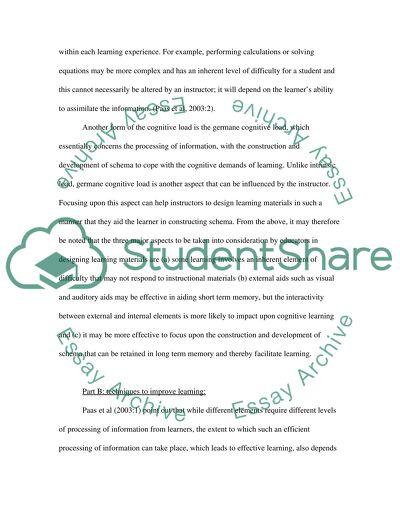Cite this document
(Cognitive Load Theory Prerequisites Essay Example | Topics and Well Written Essays - 1500 words, n.d.)
Cognitive Load Theory Prerequisites Essay Example | Topics and Well Written Essays - 1500 words. https://studentshare.org/education/1557783-discuss-the-underlying-cognitive-structures-and-processes-that-form-cognitive-load-theory-discuss-at-least-three-instructional-techniques-that-are-generated-from-this-theory-and-apply-them-to-an-area-of-interest-to-you
Cognitive Load Theory Prerequisites Essay Example | Topics and Well Written Essays - 1500 words. https://studentshare.org/education/1557783-discuss-the-underlying-cognitive-structures-and-processes-that-form-cognitive-load-theory-discuss-at-least-three-instructional-techniques-that-are-generated-from-this-theory-and-apply-them-to-an-area-of-interest-to-you
(Cognitive Load Theory Prerequisites Essay Example | Topics and Well Written Essays - 1500 Words)
Cognitive Load Theory Prerequisites Essay Example | Topics and Well Written Essays - 1500 Words. https://studentshare.org/education/1557783-discuss-the-underlying-cognitive-structures-and-processes-that-form-cognitive-load-theory-discuss-at-least-three-instructional-techniques-that-are-generated-from-this-theory-and-apply-them-to-an-area-of-interest-to-you.
Cognitive Load Theory Prerequisites Essay Example | Topics and Well Written Essays - 1500 Words. https://studentshare.org/education/1557783-discuss-the-underlying-cognitive-structures-and-processes-that-form-cognitive-load-theory-discuss-at-least-three-instructional-techniques-that-are-generated-from-this-theory-and-apply-them-to-an-area-of-interest-to-you.
“Cognitive Load Theory Prerequisites Essay Example | Topics and Well Written Essays - 1500 Words”. https://studentshare.org/education/1557783-discuss-the-underlying-cognitive-structures-and-processes-that-form-cognitive-load-theory-discuss-at-least-three-instructional-techniques-that-are-generated-from-this-theory-and-apply-them-to-an-area-of-interest-to-you.


